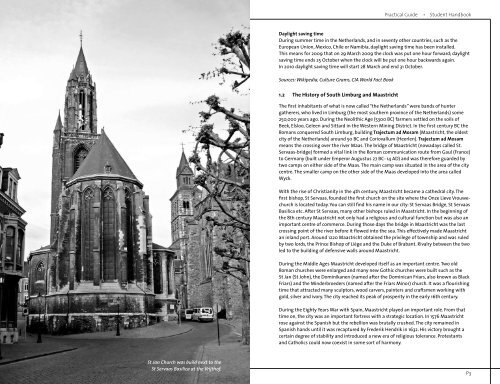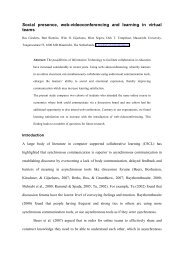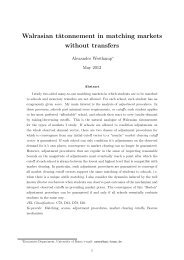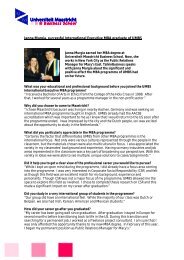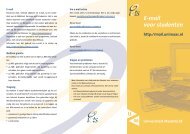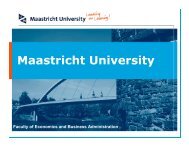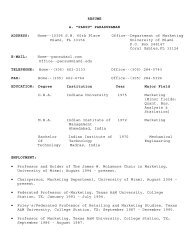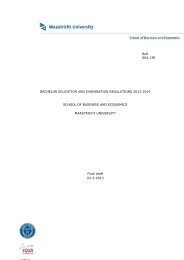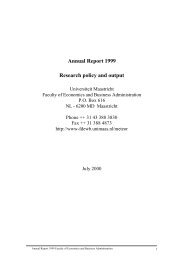Student Handbook - School of Business and Economics - Maastricht ...
Student Handbook - School of Business and Economics - Maastricht ...
Student Handbook - School of Business and Economics - Maastricht ...
You also want an ePaper? Increase the reach of your titles
YUMPU automatically turns print PDFs into web optimized ePapers that Google loves.
<strong>Student</strong> <strong>H<strong>and</strong>book</strong> • Practical Guide<br />
Practical Guide • <strong>Student</strong> <strong>H<strong>and</strong>book</strong><br />
Daylight saving time<br />
During summer time in the Netherl<strong>and</strong>s, <strong>and</strong> in seventy other countries, such as the<br />
European Union, Mexico, Chile or Namibia, daylight saving time has been installed.<br />
This means for 2009 that on 29 March 2009 the clock was put one hour forward; daylight<br />
saving time ends 25 October when the clock will be put one hour backwards again.<br />
In 2010 daylight saving time will start 28 March <strong>and</strong> end 31 October.<br />
Sources: Wikipedia, Culture Grams, CIA World Fact Book<br />
1.2 The History <strong>of</strong> South Limburg <strong>and</strong> <strong>Maastricht</strong><br />
The first inhabitants <strong>of</strong> what is now called “the Netherl<strong>and</strong>s” were b<strong>and</strong>s <strong>of</strong> hunter<br />
gatherers, who lived in Limburg (the most southern province <strong>of</strong> the Netherl<strong>and</strong>s) some<br />
250,000 years ago. During the Neolithic Age (5300 BC) farmers settled on the soils <strong>of</strong><br />
Beek, Elsloo, Geleen <strong>and</strong> Sittard in the Western Mining District. In the first century BC the<br />
Romans conquered South Limburg, building Trajectum ad Mosam (<strong>Maastricht</strong>, the oldest<br />
city <strong>of</strong> the Netherl<strong>and</strong>s) around 50 BC <strong>and</strong> Coriovallum (Heerlen). Trajectum ad Mosam<br />
means the crossing over the river Maas. The bridge <strong>of</strong> <strong>Maastricht</strong> (nowadays called St.<br />
Servaas-bridge) formed a vital link in the Roman communication route from Gaul (France)<br />
to Germany (built under Emperor Augustus 27 BC- 14 AD) <strong>and</strong> was therefore guarded by<br />
two camps on either side <strong>of</strong> the Maas. The main camp was situated in the area <strong>of</strong> the city<br />
centre. The smaller camp on the other side <strong>of</strong> the Maas developed into the area called<br />
Wyck.<br />
With the rise <strong>of</strong> Christianity in the 4th century, <strong>Maastricht</strong> became a cathedral city. The<br />
first bishop, St Servaas, founded the first church on the site where the Onze Lieve Vrouwechurch<br />
is located today. You can still find his name in our city: St Servaas Bridge, St Servaas<br />
Basilica etc. After St Servaas, many other bishops ruled in <strong>Maastricht</strong>. In the beginning <strong>of</strong><br />
the 8th century <strong>Maastricht</strong> not only had a religious <strong>and</strong> cultural function but was also an<br />
important centre <strong>of</strong> commerce. During those days the bridge in <strong>Maastricht</strong> was the last<br />
crossing point <strong>of</strong> the river before it flowed into the sea. This effectively made <strong>Maastricht</strong><br />
an inl<strong>and</strong> port. Around 1220 <strong>Maastricht</strong> obtained the privilege <strong>of</strong> township <strong>and</strong> was ruled<br />
by two lords, the Prince Bishop <strong>of</strong> Liège <strong>and</strong> the Duke <strong>of</strong> Brabant. Rivalry between the two<br />
led to the building <strong>of</strong> defensive walls around <strong>Maastricht</strong>.<br />
During the Middle Ages <strong>Maastricht</strong> developed itself as an important centre. Two old<br />
Roman churches were enlarged <strong>and</strong> many new Gothic churches were built such as the<br />
St Jan (St John), the Dominikanen (named after the Dominican Friars, also known as Black<br />
Friars) <strong>and</strong> the Minderbroeders (named after the Friars Minor) church. It was a flourishing<br />
time that attracted many sculptors, wood carvers, painters <strong>and</strong> craftsmen working with<br />
gold, silver <strong>and</strong> ivory. The city reached its peak <strong>of</strong> prosperity in the early 16th century.<br />
During the Eighty Years War with Spain, <strong>Maastricht</strong> played an important role. From that<br />
time on, the city was an important fortress with a strategic location. In 1576 <strong>Maastricht</strong><br />
rose against the Spanish but the rebellion was brutally crushed. The city remained in<br />
Spanish h<strong>and</strong>s until it was recaptured by Frederik Hendrik in 1632. His victory brought a<br />
certain degree <strong>of</strong> stability <strong>and</strong> introduced a new era <strong>of</strong> religious tolerance. Protestants<br />
<strong>and</strong> Catholics could now coexist in some sort <strong>of</strong> harmony.<br />
P2<br />
St Jan Church was build next to the<br />
St Servaas Basilica at the Vrijth<strong>of</strong>.<br />
P3


